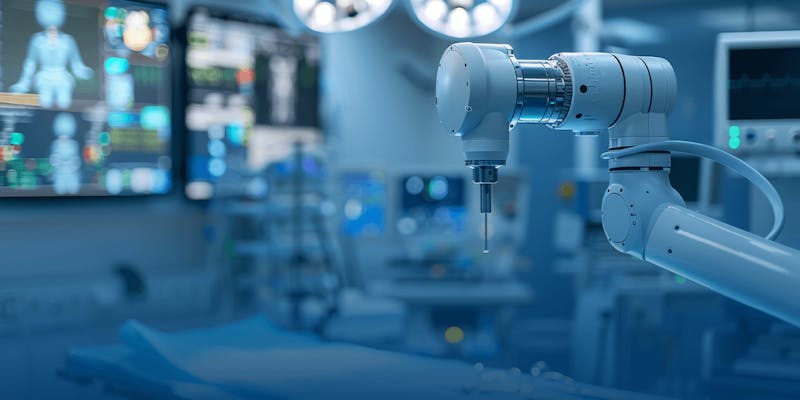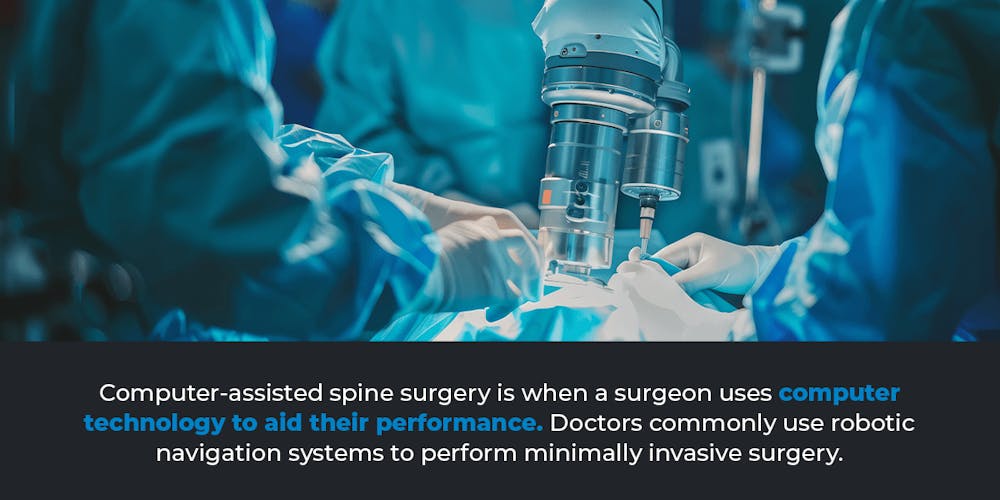
If you’re experiencing debilitating back pain that has not responded to nonsurgical treatments, your doctor may recommend spine surgery. You are not alone if you’re considering back surgery. Physicians perform approximately 1.2 million spine procedures in the United States annually to treat conditions like herniated discs and spinal stenosis. About 75% of these procedures can be performed partially or entirely through minimally invasive surgery techniques.
Minimally invasive spine surgery involves making smaller incisions than traditional or “open” back surgery. It reduces contact with surrounding tissues and muscles, typically leading to faster recovery times and fewer health risks for patients. Doctors can use computer-assisted surgical systems to perform minimally invasive procedures.
What Is Computer-Assisted Spine Surgery?
Computer-assisted spine surgery is when a surgeon uses computer technology to aid their performance. Although different technologies are available to assist, doctors commonly use robotic navigation systems to perform minimally invasive surgery. These robotically assisted systems typically include a navigation camera, specialized software, a robotic arm and a control console.

Here’s an overview of how robotic spine surgery works:
- The surgeon downloads computed tomography (CT) images of the patient’s spine and enters their procedural plan into the surgical system’s software.
- The software generates a 3D model of the patient’s spine so the surgeon can see a clear map of the patient’s anatomy on the system’s console.
- A navigation camera tracks the actual position of the surgical instruments attached to a robotic arm, which is matched to the 3D image and displayed on the console.
- The surgeon can maneuver the instruments from the console using the robotic arm and see where they are precisely positioned.
- The system provides real-time navigational guidance and feedback, facilitating accurate placement and movement of surgical tools.
Surgeons have been using robotically assisted equipment to perform spine surgeries since 2004, and the technology continues to advance.
Is Computer-Assisted Surgery the Same as Robotic Spine Surgery?
Computer-assisted surgery and robotic spine surgery do not mean the same thing. That’s because computer-assisted surgery is a broad term that may include technology that’s not robotic. However, robotic spine surgery is a type of computer-assisted surgery. A robotic device connects to computer software, and the two work together to provide real-time, high-precision navigational guidance.
It’s important to note that the robotic arm used in computer-assisted spine surgery is not technically a robot because it requires the surgeon’s control to perform.
What Are the Benefits of Computer-Assisted Spine Surgery?
Computer-assisted surgical systems, like robotically assisted technologies, are widely used by surgeons because they bring the following benefits:
Increased Accuracy
Robotic navigation systems provide a magnified view of the surgical field and real-time feedback. This helps to ensure surgeons correctly place and align implants, like pedicle screws. For example, a review of 20 controlled trials confirmed that pedicle screw placement is more accurate in robotic surgeries than traditional surgeries. Surgeons often use pedicle screws during spinal fusions to add extra support while the fusion heals.
Another reason why robot technology helps with accuracy is it allows greater maneuverability in a confined surgical space. A surgeon can maneuver a robotic arm 360 degrees and manipulate surgical instruments with great dexterity from the system’s console.
Smaller Incisions
With traditional open surgery, a surgeon may need to make a large incision and move muscle and tissue out of the way to access the surgery site. These actions can lead to muscle and tissue damage and a longer recovery.
Since a robotically assisted system can perform complex movements in a tiny space, the surgeon can make a small incision to complete the procedure. A small incision creates a less noticeable scar and offers other benefits such as:
- Less trauma to surrounding tissues.
- Reduced blood loss.
- Lower risk of infection.
- Decreased risk of postoperative pain.
All of the above factors can contribute to a faster recovery time.
Reduced Radiation Exposure
Without robotically assisted navigation systems, surgeons may need to take a greater number of X-ray images during the procedure to confirm they accurately place implants and instruments. Although doctors may still need to take images during or before robotic-assisted surgery, they might not need as many overall due to the system’s accurate navigational guidance. As a result, robotic spine surgery can mean reduced radiation exposure for both patients and surgeons.
What Common Conditions Are Treated by Robotic Spine Surgery?
Robotic technology may be used to assist with treating any of the following conditions:
- Herniated discs: A herniated disc is an injury to a disc located between spinal vertebrae. In severe cases, a computer-assisted discectomy may be performed to remove the injured part of the disc and relieve pressure on the nerves and spine.
- Scoliosis: Affecting as many as nine million people in the United States, scoliosis is a curvature of the spine that can lead to back pain. Doctors might recommend a surgical procedure, such as a spinal fusion, to treat scoliosis in adults if the curve is more than 45 to 50 degrees.
- Spinal compression fracture: A spinal compression fracture is when the vertebral bone cracks or breaks. Spinal compression fractures often heal on their own without surgical treatment. In rare cases, a spinal fusion or kyphoplasty may be performed to treat spinal fractures.
- Spinal stenosis: Spinal stenosis is when the spaces around the spine narrow. Doctors might recommend a laminectomy if the condition is severe and does not respond to other treatments. Surgeons perform roughly 600,000 surgeries in the United States each year to treat lumbar spinal stenosis.
Robotic spine surgery can also be used to treat rarer conditions, like spinal infections or tumors.
What Is the Recovery Time of Robotic Spine Surgery?
In general, you can expect to recover from robotically assisted spine surgery in about six weeks. Many patients who undergo minimally invasive spine surgery can perform their regular daily tasks after a month.
The rate at which you recover can be impacted by factors like your overall health, lifestyle and the procedure’s complexity. Your doctor might recommend avoiding lifting heavy objects or performing strenuous work for about a month after surgery to facilitate healing.
A minimally invasive procedure like robotically assisted surgery will have a shorter recovery window than traditional surgery. Recovering from a traditional procedure involving a large incision can take a year or longer.
Contact New York Spine Institute to Learn More
Advancements in surgical equipment and technology have empowered medical professionals to perform minimally invasive spinal surgeries for the benefit of their patients. Still, spinal surgery is a major procedure that’s typically reserved as a last resort to treating back pain.
If you’re wondering whether surgery is necessary to treat a spine condition, we’re here to guide you at New York Spine Institute (NYSI). We are one of the largest multispecialty spine and orthopedic centers in the tri-state region, serving patients in New York City and throughout the metropolitan area. Our expert spine specialists and surgeons have experience treating many types of spine conditions, including complex diagnoses.
Whether you experience chronic back pain and need a diagnosis or want a second opinion of a doctor’s recommendation to get spine surgery, please do not hesitate to contact our experienced and compassionate team.
Discover how our specialists can help. Contact NYSI today.

